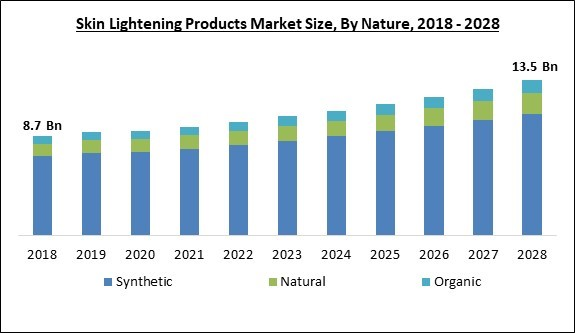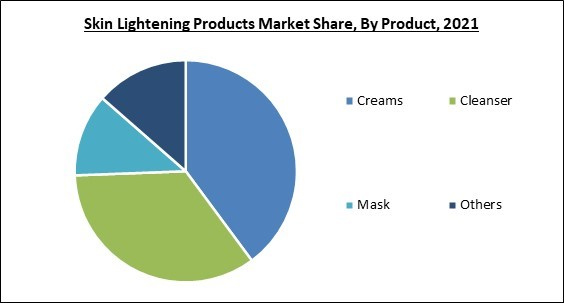The Global Skin Lightening Products Market size is expected to reach $13.5 billion by 2028, rising at a market growth of 5.3% CAGR during the forecast period.
Skin lightening creams, also known as bleaching creams, whitening strips, skin brighteners, or fading creams, function by lowering melanin, a pigment found in the skin. Tone correctors are often used to treat skin concerns such as aging skin, acne scars, and hormone discoloration. They are also used to lighten naturally dark skin.
Reducing pigmentation, lightening discolorations, promoting even skin complexion, and eliminating blemishes are all advantages of skin lightening products. The increased use of different skin lighteners in the market is due to customers' growing need for a specialized solution to diverse skin concerns, such as aging spots or acne spot removal. As a result, manufacturers are creating lightening items to meet a variety of consumer demands.
The quantity of melanin pigment determines skin color. Melanin is a pigment produced by melanocytes, which are specialized cells. Melanin is more prominent in dark-skinned people. The amount of melanin in skin is mostly determined by genetic makeup. Melanin production can be influenced by factors such as sunlight, hormones, skin injury, and chemical exposure. Skin color changes usually go away on their own. Tans, for example, fade if the quantity of direct sunshine exposure is reduced. Certain slight discoloration, such as 'age' patches or 'liver' spots, however, somehow become permanent with time.
Skin bleaching is a cosmetic technique that lightens the appearance of skin with slight discoloration and evens out the skin's color. Bleaching lotions are available both over the counter and by medication.
In the United States, the FDA controls the use of hydroquinone. Hydroquinone can be found in over-the-counter skin lighteners in concentrations of up to 2%. Lighteners containing 4 percent to 6 percent hydroquinone can be prescribed by dermatologists. Before using a product containing hydroquinone, consult doctor and follow the doctor's instructions to the letter. Other skin lighteners contain active substances such as steroids and retinoids, which is derived from vitamin A. Some skin lighteners also contain natural chemicals including kojic acid, a fungus-derived compound, and arbutin, a plant-derived compound.
The market research report covers the analysis of key stake holders of the market. Key companies profiled in the report include L'Oreal Group, The Procter and Gamble Company, Unilever PLC, Shiseido Company, Limited, Beiersdorf AG, The Himalaya Wellness Company (Himalaya Global Holdings Ltd.), Kao Corporation (Kanebo Cosmetics, Inc.), Vlcc Health Care Limited, Avon Products, Inc., and Dabur India Ltd.
By Product
Skin lightening creams, also known as bleaching creams, whitening strips, skin brighteners, or fading creams, function by lowering melanin, a pigment found in the skin. Tone correctors are often used to treat skin concerns such as aging skin, acne scars, and hormone discoloration. They are also used to lighten naturally dark skin.
Reducing pigmentation, lightening discolorations, promoting even skin complexion, and eliminating blemishes are all advantages of skin lightening products. The increased use of different skin lighteners in the market is due to customers' growing need for a specialized solution to diverse skin concerns, such as aging spots or acne spot removal. As a result, manufacturers are creating lightening items to meet a variety of consumer demands.
The quantity of melanin pigment determines skin color. Melanin is a pigment produced by melanocytes, which are specialized cells. Melanin is more prominent in dark-skinned people. The amount of melanin in skin is mostly determined by genetic makeup. Melanin production can be influenced by factors such as sunlight, hormones, skin injury, and chemical exposure. Skin color changes usually go away on their own. Tans, for example, fade if the quantity of direct sunshine exposure is reduced. Certain slight discoloration, such as 'age' patches or 'liver' spots, however, somehow become permanent with time.
Skin bleaching is a cosmetic technique that lightens the appearance of skin with slight discoloration and evens out the skin's color. Bleaching lotions are available both over the counter and by medication.
In the United States, the FDA controls the use of hydroquinone. Hydroquinone can be found in over-the-counter skin lighteners in concentrations of up to 2%. Lighteners containing 4 percent to 6 percent hydroquinone can be prescribed by dermatologists. Before using a product containing hydroquinone, consult doctor and follow the doctor's instructions to the letter. Other skin lighteners contain active substances such as steroids and retinoids, which is derived from vitamin A. Some skin lighteners also contain natural chemicals including kojic acid, a fungus-derived compound, and arbutin, a plant-derived compound.
COVID-19 Impact Analysis
The emergence of COVID-19 has led to a shift in consumer preferences, with more people looking for energetic and multifunctional skincare products, which is projected to drive market expansion during the forecast period. As a result, manufacturers are launching new items to meet shifting consumer demands. For example, Shiseido Co., Ltd., a Japanese cosmetics business, launched Anissa, a multifunctional sunscreen, in June 2021. M-tranexamic acid, a brightening active that helps suppress the synthesis of melanin, is one of the 50 percent skincare ingredients in the product.Market Growth Factors
Multiple advantages of applying skin lightening products
Skin whitening solutions, can brighten the skin tone by lightening the facial hair and making it less apparent. Skin whitening treatments reduce the amount of melanin in the skin, resulting in a lighter skin tone, the removal of dullness, and the enhancement of the skin tone. Another benefit of using skin lightening solutions is that they offer a healthy shine. Due to the upper layer of the skin is revitalized when using skin lightening solutions, skin tone becomes fairer and receives a shine on the face. Skin whitening products, on the other hand, should not be used daily. Sun whitening treatments also aid in the removal of sun tanning and sunburn induced by the sun's rays. The use of skin whitening creams reduces and fades tan and sunburn.Aged people are more worried about their skin tone
Since the skin is the most visible organ, humans are always aware of the aging process. Plant leaf extract and herbs have been used since ancient times. Clinically, chronologically and photo-aging can be differentiated, but they share essential molecular characteristics. attempted to compile the most compelling information based on plant facts and plant extracts used in antiaging treatments. The main goal of this study was to highlight the action mechanisms of various plant/herbal compounds, or their 'strategies' for combating skin aging.Market Restraining Factors
Some skin types are ineffective.
Natural skin lightening cosmetics are certainly safer, some components are incompatible with specific skin types and, if not used properly, can even cause outbreaks. For example, if a consumer has oily skin, aloe Vera or witch hazel can help them avoid clogging their pores, while dry skin types can benefit from coconut oil's antibacterial and hydrating characteristics. On the other hand, skin rashes caused by chemical-based cosmetic and makeup cleaning products are projected to impede market expansion. On different skin types, different skincare products have varied effects. For some skin types, the result is helpful, while for others, the results are terrible, such as allergic reactions and even worse.Product Outlook
Based on Product, the market is segmented into Creams, Cleanser, Mask, and Others. The cleanser segment witnessed a significant revenue share in the skin lightening products market in 2021. Because of its number of advantages such as lightening discoloration, reducing pigmentation, and removing blemishes, it is expected to acquire popularity among consumers.Nature Outlook
Based on Nature, the market is segmented into Synthetic, Natural, and Organic. The synthetic segment procured the largest revenue share in the skin lightening products market in 2021. Due to their significant influence on the skin, these chemical compounds assist to speed up the lightning process of synthetics cosmetics. Dermatology and cosmetics utilize chemical compounds to de-pigment the skin, which is driving their use in conventional products.Regional Outlook
Based on Regions, the market is segmented into North America, Europe, Asia Pacific, and Latin America, Middle East & Africa. The Asia Pacific region garnered the highest revenue share in the skin lightening products market in 2021. To achieve maximum client penetration in the country, major firms in the region are employing a variety of techniques. product, and visibility among consumers. In the forecast future, such growth initiatives by prominent firms is expected to increase the regional market.The market research report covers the analysis of key stake holders of the market. Key companies profiled in the report include L'Oreal Group, The Procter and Gamble Company, Unilever PLC, Shiseido Company, Limited, Beiersdorf AG, The Himalaya Wellness Company (Himalaya Global Holdings Ltd.), Kao Corporation (Kanebo Cosmetics, Inc.), Vlcc Health Care Limited, Avon Products, Inc., and Dabur India Ltd.
Scope of the Study
Market Segments Covered in the Report:
By Product
- Creams
- Cleanser
- Mask
- Others
- Synthetic
- Natural
- Organic
- North America
- US
- Canada
- Mexico
- Rest of North America
- Europe
- Germany
- UK
- France
- Russia
- Spain
- Italy
- Rest of Europe
- Asia Pacific
- China
- Japan
- India
- South Korea
- Singapore
- Malaysia
- Rest of Asia Pacific
- LAMEA
- Brazil
- Argentina
- UAE
- Saudi Arabia
- South Africa
- Nigeria
- Rest of LAMEA
Key Market Players
List of Companies Profiled in the Report:
- L'Oreal Group
- The Procter and Gamble Company
- Unilever PLC
- Shiseido Company, Limited
- Beiersdorf AG
- The Himalaya Wellness Company (Himalaya Global Holdings Ltd.)
- Kao Corporation (Kanebo Cosmetics, Inc.)
- Vlcc Health Care Limited
- Avon Products, Inc.
- Dabur India Ltd.
Unique Offerings from the Publisher
- Exhaustive coverage
- The highest number of Market tables and figures
- Subscription-based model available
- Guaranteed best price
- Assured post sales research support with 10% customization free
Table of Contents
Chapter 1. Market Scope & Methodology
Chapter 2. Market Overview
Chapter 3. Global Skin Lightening Products Market by Product
Chapter 4. Global Skin Lightening Products Market by Nature
Chapter 5. Global Skin Lightening Products Market by Region
Chapter 6. Company Profiles
Companies Mentioned
- L'Oreal Group
- The Procter and Gamble Company
- Unilever PLC
- Shiseido Company, Limited
- Beiersdorf AG
- The Himalaya Wellness Company (Himalaya Global Holdings Ltd.)
- Kao Corporation (Kanebo Cosmetics, Inc.)
- Vlcc Health Care Limited
- Avon Products, Inc.
- Dabur India Ltd.
Methodology

LOADING...










